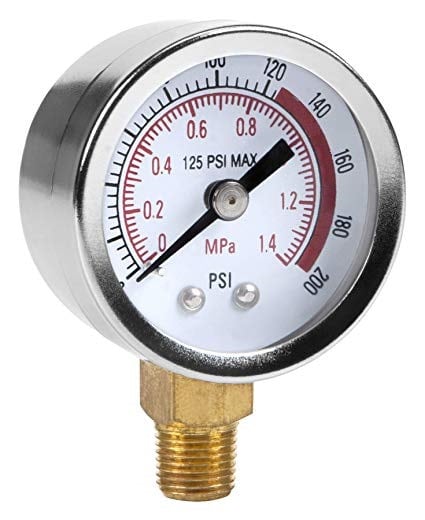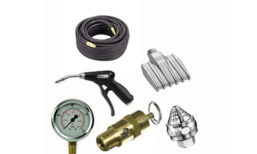

Pressure Gauges
The number and type of gauges on an air compressor unit vary depending on its model and type.
Modern air compressors typically feature electronic controllers with digital gauges for pressure monitoring and reporting. However, simpler machines like piston compressors may have one or two analog gauges. One gauge measures the pressure leaving the compression chamber, while another monitors the pressure in the tank.
An analog gauge typically reads in PSI (pounds per square inch), indicating the pressure of the air in a specific space.
When reading gauges, it's essential to understand the difference between PSIA (pounds per square inch absolute or atmospheric) and PSIG (pounds per square inch gauge). PSIA starts from complete zero in a perfect vacuum, equivalent to atmospheric pressure. PSIG, on the other hand, measures pressure relative to atmospheric pressure.
The pressure switch, found in some piston compressors, measures the outlet pressure of the pump. For instance, in select piston compressors, a 175/135 psi stop/start mechanism is utilised. This mechanism triggers the motor to turn off when the tank gauge reads 175 psi and restarts it when the pressure drops below 135 psi.
If a gauge does not show zero when the unit is off and the tank is empty, it needs calibration. This is typically done by adjusting a screw or knob to zero the dial when the unit is off.
Atmospheric pressure is assumed to be 14.7 psi for most technical data calculations. However, this may vary based on elevation, with higher elevations experiencing lower atmospheric pressure, affecting compressor performance.
For further information on gauges and their use in air compressors, it's advisable to consult an expert.
Did you find what you were looking for?
The system
Pressure gauges are installed throughout compressed air systems in order to monitor, record or view system pressure. The closer to the generating equipment (air compressor), the higher the pressure is likely to be. When two gauges are installed either side of something, a filter, as an example, the gauges will indicate the differential pressure between the inlet and the outlet of the filter assembly. TSSA requires a pressure gauge, positioned for clear and easy visualisation on all types of pressure vessels.
Frequently Asked Questions
What else do Kaeser and Air Solutions Canada offer?
Rotary Vacuum and Rotary Blowers are other facets of Kaeser's product range.
Air Solutions will design, build and install any of the Kaeser range of products, including compressors, vacuums, blowers and a full range of clean air treatments. Our turnkey approach to rigging, piping, ductwork and electrical, means that one call does it all.
Do you offer delivery and pickup services?
Yes, we offer delivery and pickup services for all of our rental equipment. We'll work with you to schedule a convenient time for delivery and pickup that works with your schedule.
How it works
Our tried-and-tested approach to get you a reliable compressed air solution at the lowest possible cost of ownership looks like this:

Discovery call
Our solutions specialist visits your facility to discuss your current situation, pain points, future plans, and potential government incentives. We can undertake as little, or as much, of your project as you would like.

Requirement analysis
We analyze the compressed air equipment at your facility, its performance, condition, control mechanisms, and suitability. We ensure that storage, piping, and compressed air quality are in line with your requirements and best practices.

Turnkey design and installation
Everything we do is “in house.” Compressed air system design, air audits, leak detection, design, build, installation, and air compressor service are handled quickly and efficiently. This approach means that we manage every aspect of your project and create single source supply for you and your organization.

Maintenance and repair
Whether you require emergency breakdown response, predictive, or preventative maintenance our team has you covered. Air end and motor service and rebuilds, piping system, and analysation are also available.


